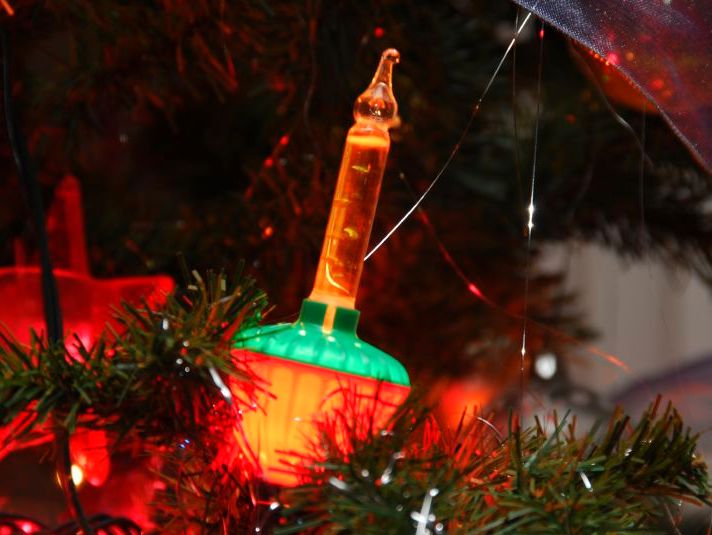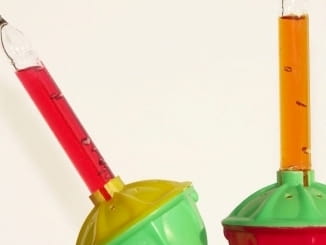Bubble Lights - The Hazards of Nostalgia

The Bottom Line
Bubble lights may contain methylene chloride. If swallowed or absorbed through the skin, methylene chloride becomes carbon monoxide inside the body.

The Full Story
Decorating our homes for the holidays is a much-loved ritual. Often, we retrieve heirloom pieces passed down through generations to remind us of our traditions at this time of year. It is important to remember, however, that safety standards have changed vastly over the past century. Some of our familiar holiday mementos could actually be dangerous.
Since the advent of electric lights, few people place lighted candles on Christmas trees, a common practice in prior centuries. But, some of us might be tempted to pull out those old bubble lights that were popular in the 1950s through the 1970s. (In fact, bubble lights are so popular that new bubble lights now are available.) Their "candle" shape, liquid movement under the glass, and bright colors make them attractive and appealing, especially to young children.
Underneath their joyful appearance, there lurks a hidden hazard. The fluid inside old or new bubble lights most frequently is methylene chloride. Methylene chloride can cause serious poisoning if it is inhaled, swallowed, or spilled on the skin. In the body, methylene chloride is converted to carbon monoxide. The symptoms are the same as from other sources of carbon monoxide: nausea, vomiting, headache, drowsiness, coma, seizures, heart attack, and even death.
Also, many of these antiques have become fragile with age. They can break very easily in the hands of active children. (Cuts from broken glass are a common holiday injury.) Fortunately, the amount of fluid in a single bulb is very small and usually not enough to cause serious poisoning. However, it is important for parents to remain vigilant and discourage children from playing with these lights.
Poison Control is here to help 24 hours a day, holidays included. If someone breaks a bubble light or you suspect a poisoning from other holiday decorations, call Poison Control right away at 1-800-222-1222.
Nicole Reid, RN, BSN, MEd
Certified Specialist in Poison Information
Poisoned?
Call 1-800-222-1222 or
Prevention Tips
Discourage children from playing from holiday bubble lights. The liquid inside might be poisonous. Also, they could be fragile and cause cuts from broken glass.This Really Happened
Case 1: A 20-month-old boy was found with a broken holiday bubble night light. He might have swallowed the contents. Since Poison Control couldn't estimate how much of the bubble light fluid he swallowed, he was referred in to the nearest emergency room. He was evaluated for potential carbon monoxide poisoning from the methylene chloride in the fluid. The child did not have any ill effects and was released home.
Case 2: A 29-year-old 20-weeks-pregnant caller told Poison Control that she cleaned up two broken bubble holiday lights and had gotten some of the liquid on her hands. She quickly washed her hands. Poison Control reassured her that though the bubble light fluid can be quite hazardous if swallowed or absorbed through the skin in large amounts, the quantity she got on her skin might cause irritation but would not harm her or the baby.
References
Otis, CW, inventor. Ornamental illuminating device. United States patent US 2,353,063. 1944, July 4.
Poisoned?
Call 1-800-222-1222 or
Prevention Tips
Discourage children from playing from holiday bubble lights. The liquid inside might be poisonous. Also, they could be fragile and cause cuts from broken glass.This Really Happened
Case 1: A 20-month-old boy was found with a broken holiday bubble night light. He might have swallowed the contents. Since Poison Control couldn't estimate how much of the bubble light fluid he swallowed, he was referred in to the nearest emergency room. He was evaluated for potential carbon monoxide poisoning from the methylene chloride in the fluid. The child did not have any ill effects and was released home.
Case 2: A 29-year-old 20-weeks-pregnant caller told Poison Control that she cleaned up two broken bubble holiday lights and had gotten some of the liquid on her hands. She quickly washed her hands. Poison Control reassured her that though the bubble light fluid can be quite hazardous if swallowed or absorbed through the skin in large amounts, the quantity she got on her skin might cause irritation but would not harm her or the baby.
